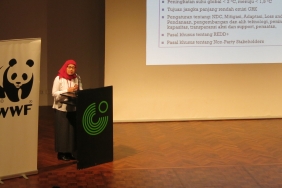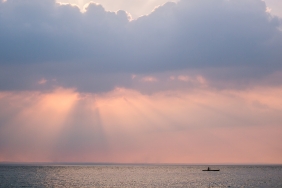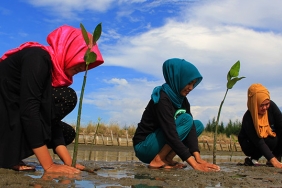THE GENTLE GIANT, GURANO BINTANG, INTO ACADEMIC SUBJECT
by: Casandra Tania
Manokwari (18/06) – Universitas Negeri Papua (UNIPA) supported by WWF-Indonesia held a general lecture about biological and ecological aspects of whale shark (Rhincodon typus), some findings from previous whale shark studies and their implications to management in Fisheries Building Hall, UNIPA. The keynote speaker, Brent Stewart, Ph.D., J.D., is a senior marine ecologist from Hubbs Seaworld Research Institute, San Diego, California, USA and also one of WWF-Indonesia science partners.
Dr. Stewart’s expertise covers marine mammals and sea birds with working areas from Arctic to Antarctica. He has worked with whale sharks for more than 10 years and until now he is still collaborating with WWF-Philippines on whale shark issues in Donsol, Philippines. Other countries where Dr. Stewart has done research collaborations are Kenya, Maldives, and Australia.
The lecture started at 9.30 WIT and formally opened by UNIPA Dean, Dr. Suriel S. Mofu, S.Pd, M.Ed., M.Phil (Oxon), and WWF-Indonesia representative, Herman Orisu. Dr. Stewart delivered a presentation with translation and interpretation help from WWF-Indonesia staff, Casandra Tania.
Whale shark is the biggest fish on the planet. However, ironically our knowledge about them which are usually called gurano bintang or hiu bodoh (innocent shark) by the locals is still very limited.
In the sea, only adolescent male whale sharks with the size range between 3 – 8 m are often seen. Because of that, our general knowledge about whale sharks is limited to these individuals. Basic questions like where the females, where the juveniles, and where their mating or giving birth are still unanswered.
Collaborating with Teluk Cenderawasih National Park (BBTNTC), UNIPA, and WWF-Indonesia, Dr. Stewart studies the movement of whale shark by deploying 6 satellite tags; 1 unit in May 2011 and 5 units in November 2011 (4 of 5 tags were provided by CII donors). The deployment of satellite tags helps us to know more about the movement pattern of whale sharks, either horizontally (geographically) or vertically (by different depth).
From satellite tag data, we know that whale sharks are mobile animals which are constantly moving (either horizontally or vertically). They often swim in the depth (100 – 200 m), while occasionally they also dove to a very deep depth (can be up to 1.800 m). They are hardly seen by people because they come to (or close to) the surface very rarely.
In 10-14 June 2012, as a part of Gurano Bintang Expedition (9-18 June 2012), another tagging activity by using Radio Frequency Identifications (RFIDs) had been conducted. RFID acts like a barcode tool that will give a permanent identification to one individual. By using RFID, we can distinguish one whale shark from the others. In just 4 and half days, the team had succeeded to attach RFIDs on 30 whale sharks (29 males and 1 female) in the water around Kwatisore village.
Dr. Stewart said that the whale sharks in Kwatisore which is a part of Teluk Cenderawasih National Park are very unique! Different to other places, visitors who want to see/swim with whale sharks do not have to swim whole heartedly and ‘chase’ the whale sharks as they will come to us while they get attracted by the presence of small anchovies (puri) that have been caught by liftnet (bagan) fishermen.
This uniqueness is very potential for developing a whale shark based ecotourism and research. Nevertheless, the development of ecotourism should be done wisely and carefully as there are still many unknown facts about whale sharks. Research and ecotourism should go together in order to ascertain whale shark well being in and outside of the national park and to minimize some factors that are and will be threats for whale sharks.
After discussion, it was already 12 WIT and the general lecture about this gentle giant finally came to an end. Hopefully, in the future there will be more answered to all whale sharks’ related management questions that later will be used as foundation for designing and implementing management and sustainable ecotourism as well as responsible fisheries practices in the park.
For further information :
•Beny Ahadian Noor, Project Leader WWF Taman Nasional Teluk Cenderawasih, WWF-Indonesia, bnoor@wwf.or.id
•Creusa Hitipeuw, Marine Species Conservation Expert, WWF-Indonesia, chitipeuw@wwf.or.id
•Casandra Tania, Marine Species Officer, WWF-Indonesia, ctania@wwf.or.id





